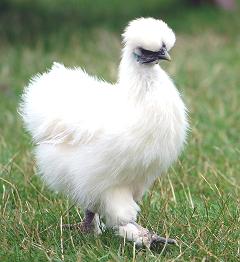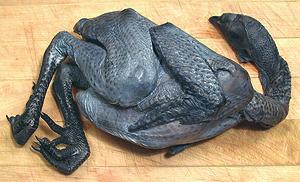Silkie Chicken
 [Black Chicken, La Soyeuse Poulet (French), Gallus gallus domesticus]
[Black Chicken, La Soyeuse Poulet (French), Gallus gallus domesticus]
This small Asian chicken possibly originated in China, or maybe
farther south, but the first written record of them is in the journals of
Marco Polo. Silkies are unlike any other chicken. They come in various
colors, white and black being most common, but their feathers are like
soft fur. This is because of a recessive gene - some dinosaurs had
feathers of this sort. The skin under those soft feathers is blue-black,
the bones are black and even the flesh is dark and bluish. They have
five toes rather than four as found on all but a few other odd types of
chicken.
Silkies grown in North American are bantam varieties that can grow to 2
pounds at full maturity, but they're generally marketed at 1 to 1-1/2
pounds. In Europe, larger silkies are grown that can reach 4 pounds when
fully mature. They are not particularly good egg layers because as soon
as they have a few eggs they want to settle down and hatch them. Good
layers are bred to not want to be bothered with hatching.
Silkies are very tame and gentle, making good pets. Hens are often
assigned to hatching the eggs and tending the chicks of less attentive
birds. They are, however, also widely eaten in East and Southeast Asia
and are considered to have strong medicinal powers. They are now grown
for the market in North America, but they'll set you back a pretty penny
- and many people here think they're just too cute to eat.
More on Chickens.
 This is what you get when you cut open the vacuum package - yup, looks a
whole lot like a dead chicken. If you have a problem with that, be aware
- it gets worse. Not only is the skin black, so are the bones, and the
flesh is blue-gray to blue-brown. The inside cavity is coal black.
This is what you get when you cut open the vacuum package - yup, looks a
whole lot like a dead chicken. If you have a problem with that, be aware
- it gets worse. Not only is the skin black, so are the bones, and the
flesh is blue-gray to blue-brown. The inside cavity is coal black.
These birds are most noted for use in Chinese tonic soups, combined
with a number of medicinal herbs and roots. They are most often prepared
for new mothers right after giving birth. Silkies are also braised and
stewed in various ways. They are not used for stir fries and other
briefly cooked dishes because they are tougher than regular chickens.
Aside from China these chickens are eaten in Southeast Asia and to a
lesser extent in Korea and Japan.
Because silkies are expensive to raise, chicken breeders are attempting
to develop more productive, normally feathered chickens with the black
flesh gene. None are currently marketed, and it's doubtful they will
be accepted as having the same medicinal properties as the silkie.
Buying:
Silkies are now easy to find frozen in markets
serving East or Southeast Asian communities. Typically they are sold with
head and feet attached under USDA Exemption Permit 101 (Buddhist
Exemption). They are expensive, typically over US $10 for a 1-1/2 pound
bird even in Los Angeles. The photo specimen to the left was grown in
Canada and weighed 1.47 pounds.
Yield:
Silkies aren't particularly meaty but they contain
almost no fat so yield is decent, about 60% edible depending on cooking
method. Most of the lost weight is in the head, neck and feet.
Prep:
For general preparation there is no significant
difference between these and Cornish game hens - except for needing to cut
off the feet and head (which are properly used in making stock).
Despite what you're told by the US FDA, the best and safest way to thaw
birds (any size) is in cold water, either in their sterile vacuum pack or
with frequent changing of the water. This method is approved by the USDA
for commercial and institutional establishments.
Cooking:
Use recipes for which the deeper flavor of
the silkie (even the breasts) will not violate the intent of the recipe
and the color won't be a problem. Keep in mind they need to be cooked
long enough to be tender. They can be used in place of game birds but
the flavor is closer to chicken.
In Asian cooking, most chickens are skinned before cooking, but these
are done skin-on. After all, when you're paying that much extra for the
skin color you don't want to throw it out - and unlike normal domestic
chickens there is almost no fat under the skin.
bd_chksilkz 090607 - www.clovegarden.com
©Andrew Grygus - agryg@clovegarden.com - Photos
on this page not otherwise credited © cg1
- Linking to and non-commercial use of this page permitted
 This is what you get when you cut open the vacuum package - yup, looks a
whole lot like a dead chicken. If you have a problem with that, be aware
- it gets worse. Not only is the skin black, so are the bones, and the
flesh is blue-gray to blue-brown. The inside cavity is coal black.
This is what you get when you cut open the vacuum package - yup, looks a
whole lot like a dead chicken. If you have a problem with that, be aware
- it gets worse. Not only is the skin black, so are the bones, and the
flesh is blue-gray to blue-brown. The inside cavity is coal black. [Black Chicken, La Soyeuse Poulet (French), Gallus gallus domesticus]
[Black Chicken, La Soyeuse Poulet (French), Gallus gallus domesticus]